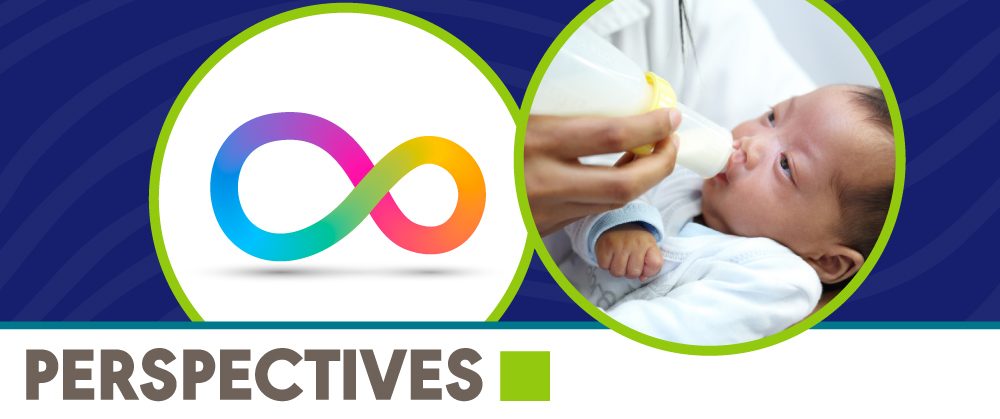ASHA’s clinicians work in a variety of different roles, with multiple populations, and across many settings. In fact, this may be your reality right now! If so, keep on reading—because you’re going to want to hear this.
Since its inception, Perspectives of the ASHA Special Interest Groups has provided clinically relevant information for all ASHA members. The latest issue of Perspectives contains forums on two topics: (1) intersectional approaches to language in autism and (2) feeding infants with cleft and craniofacial conditions. Read more below!
Intersectional Approaches to Language in Autism
The issue opens with a forum from Guest Editors Kelly L. Coburn and Teresa Girolamo discussing cultural considerations when working with autistic people from diverse backgrounds. In their introduction, Coburn and Girolamo highlight health care gaps for autistic individuals and people from minoritized backgrounds.
Coles-White and colleagues discuss the importance of neurodiversity-affirming care in autism—and how these practices can be culturally adjusted when working with Black autistic people. Next, Coburn goes over the roles and responsibilities of speech-language pathologists (SLPs) when working with individuals who have a self-diagnosis of autism.
Abubakare and Snedeker show that individuals with autism interpret ambiguous pronouns with the same accuracy as people without autism. Then, Papas et al. report on the experiences of an Indigenous Mayan family with a minimally speaking autistic child, highlighting the lack of resources outside of English-speaking countries. The forum closes with an article from Steinbrenner and colleagues on the use of a language assessment tool for people with autism for individuals from a variety of backgrounds.
In their introduction, Coburn and Girolamo write “Together, these articles offer new directions for thinking about how to improve health equity,” (p. 652). We hope that this forum helps you do just that—not just for people with autism but for every individual you serve.
Feeding Infants With Cleft and Craniofacial Conditions
The next forum—this one from Perspectives Editor Kazlin Mason—focuses on the SLP’s work as part of a feeding team for infants with cleft and craniofacial disorders. In her introduction to the forum, Mason describes the forum’s key objectives, including encouraging interdisciplinary collaboration and addressing training disparities.
Kotlarek et al. report on training pathways and practice patterns of infant-feeding providers around the country, highlighting the need for formal training. Next, Martin and Nimtz highlight practical tools and resources in their article on the importance of combined evaluations and collaboration with the clinical nutrition team. Finally, Chee-Williams and Kotlarek give clinicians a framework for tailoring interventions to the specific needs of infants with cleft palate.
“The integration of these evidence-based approaches into routine practice has the potential to improve the health, growth, and developmental outcomes of affected children,” writes Mason (p. 775). These techniques can also help support the families of infants with cleft and craniofacial conditions in meaningful ways.
Bridging Research and Practice With Perspectives
In addition to these forums, the June issue of Perspectives contains more than 25 articles on a variety of topics, all focused on bridging the gap between research and practice. From audiology to higher education, this issue has plenty of resources for ASHA’s clinicians.
We’d like to thank Drs. Coburn, Girolamo, and Mason for their hard work bringing these forums to Perspectives. We’d also like to thank Special Interest Group 1 (Language Learning and Education) and Special Interest Group 5 (Craniofacial and Velopharyngeal Disorders).
The articles in these forums are available free for the next 2 weeks, so be sure to read and share them with colleagues! You can read both forums in the June issue of Perspectives or explore the individual articles below.
Explore the Forums
Intersectional Approaches to Language in Autism
Abubakare, O., & Snedeker, J. (2025). Personal pronoun comprehension and theory of mind in autistic adults. Perspectives of the ASHA Special Interest Groups, 10(3), 672–690. https://doi.org/10.1044/2024_PERSP-24-00148
Coburn, K. L. (2025). Self-diagnosis of autism: What is the speech-language pathologist’s role? Perspectives of the ASHA Special Interest Groups, 10(3), 664–671. https://doi.org/10.1044/2024_PERSP-24-00110
Coburn, K. L., & Girolamo, T. (2025). Introduction to the forum: Intersectional approaches to language in autism. Perspectives of the ASHA Special Interest Groups, 10(3), 651–654. https://doi.org/10.1044/2024_PERSP-24-00250
Coles-White, D., Abubakare, O., Alexander, S. H., & Kasambira Fannin, D. (2025). Consideration of intersectionality in the context of neurodiversity-affirming services for Black autistic people. Perspectives of the ASHA Special Interest Groups, 10(3), 655–663. https://doi.org/10.1044/2024_PERSP-24-00172
Papas, A., Couoh Pool, R. M., & Butler, L. K. (2025). Úuch u náacero’ beyo’— Born this way: Experiences of autism and communication in an indigenous Yucatec Maya family in Mexico and considerations for clinical practice. Perspectives of the ASHA Special Interest Groups, 10(3), 691–703. https://doi.org/10.1044/2025_PERSP-24-00129
Steinbrenner, J. R., Jenkins, K. C., Nowell, S. W., Wilkinson, B., Salley, B., Buzhardt, J., & Boyd, B. A. (2025). Caregiver perceptions and use of the Early Communication Indicator–Autism: Examining differences among demographic groups. Perspectives of the ASHA Special Interest Groups, 10(3), 704–718. https://doi.org/10.1044/2024_PERSP-24-00136
Feeding Infants With Cleft and Craniofacial Conditions
Chee-Williams, J. L., & Kotlarek, K. (2025). A tutorial for feeding infants with orofacial clefting: General guidelines and patient-specific intervention. Perspectives of the ASHA Special Interest Groups, 10(3), 802–813. https://doi.org/10.1044/2024_PERSP-24-00179
Kotlarek, K. J., Bush, E. J., & Zarzycka, A. (2025). A qualitative inquiry of practice and training in feeding infants with orofacial clefting: Insight from four expert providers. Perspectives of the ASHA Special Interest Groups, 10(3), 777–784. https://doi.org/10.1044/2024_PERSP-23-00122
Martin, C., & Nimtz, A. (2025). Joint clinical nutrition and speech pathology clinics: A highly impactful collaboration for children with cleft lip and/or palate. Perspectives of the ASHA Special Interest Groups, 10(3), 785–801. https://doi.org/10.1044/2024_PERSP-24-00201
Mason, K. N. (2025). A multidisciplinary perspective on feeding infants with cleft palate. Perspectives of the ASHA Special Interest Groups, 10(3), 774–776. https://doi.org/ 10.1044/2025_PERSP-25-00031







